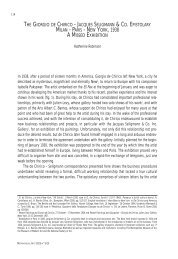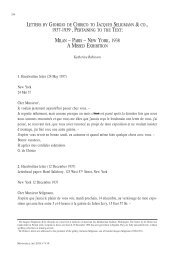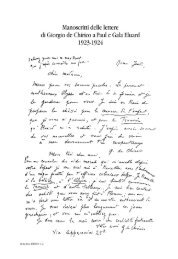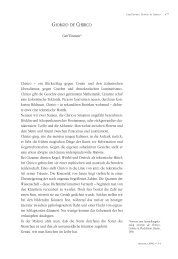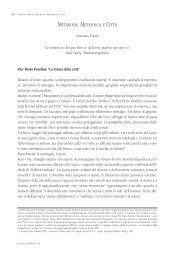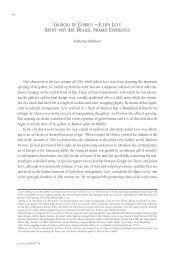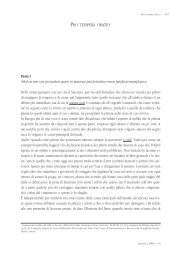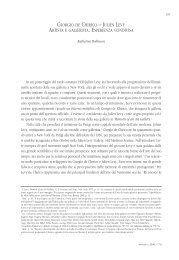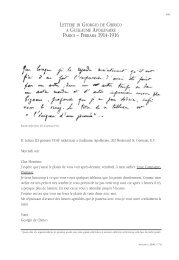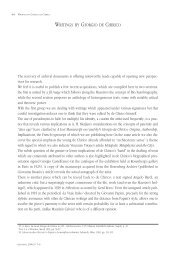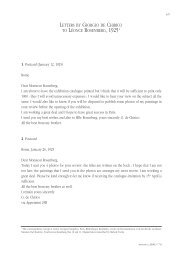Emplastic Oil - Fondazione Giorgio e Isa de Chirico
Emplastic Oil - Fondazione Giorgio e Isa de Chirico
Emplastic Oil - Fondazione Giorgio e Isa de Chirico
Create successful ePaper yourself
Turn your PDF publications into a flip-book with our unique Google optimized e-Paper software.
182<br />
SALVATORE VACANTI: FROM MURAL PAINTING TO “EMPLASTIC OIL”<br />
fig. 14 G. Sciltian, Self-portrait, 1941, oil on<br />
canvas, private collection<br />
Moreover, it is with Gazzera that <strong>de</strong> <strong>Chirico</strong> organised<br />
the provocative Antibiennale in Venice in 1950, in protest<br />
against the abstract ten<strong>de</strong>ncies of the contemporary art<br />
promoted by the official Biennale. 100<br />
The young artist Gregorio Sciltian (fig. 14) was the<br />
subject of an essay <strong>de</strong> <strong>Chirico</strong> published in “Stile” in 1941,<br />
in which he emphasised the “spectacular element” of<br />
Sciltian’s painting, specifying that this formulation referred<br />
to the “vividness” found in his figures, for which he<br />
<strong>de</strong>served to be called “[…] the ultimate [artist] of harmonious<br />
plasticity” 101 . The Armenian artist met <strong>de</strong> <strong>Chirico</strong> in<br />
the 1920s in Rome and was fascinated by his paintings,<br />
from which he culled technical lessons. Many years later<br />
Sciltian published his Trattato sulla pittura (Treatise on<br />
Painting) 102 , the theoretical section of which is influenced<br />
by <strong>de</strong> <strong>Chirico</strong>’s theoretical reflection on “craft”, while the<br />
technical section is strongly inspired by the Small Treatise. The opening passages are formulated<br />
with the same terminology and concepts found in <strong>de</strong>chirican texts from 1919 onwards:<br />
[…] I always went against the flow; I always fought relentlessly against the Tower of Babel built by<br />
Mo<strong>de</strong>rnism, because I saw the expression of <strong>de</strong>ca<strong>de</strong>nce and of a tragic annihilation in it. 103<br />
For this reason Sciltian wrote a treatise “without philosophical pretensions” that clarified his<br />
artistic i<strong>de</strong>as and was <strong>de</strong>dicated to those painters who, like him, had <strong>de</strong>ci<strong>de</strong>d “to recover the glorious<br />
lost tradition”. 104 With this end in mind, he <strong>de</strong>scribed his analysis of numerous historical manuscripts<br />
and treatises from Cennini to Armenini and so on, in the search for useful, practical advice.<br />
He - like <strong>de</strong> <strong>Chirico</strong> - favoured French and German writings from the seventeenth century, particularly<br />
De la peinture à l’huile (On <strong>Oil</strong> Painting) by J. F. L. Mérimée. <strong>Oil</strong> painting was Sciltian’s preferred<br />
medium, which he consi<strong>de</strong>red “the greatest result ever achieved by the art of painting”. 105<br />
De <strong>Chirico</strong> first praised Annigoni’s artistic qualities after the latter’s solo exhibition in 1932 in<br />
Luigi Bellini’s exhibition space in Palazzo Ferroni, where most works were painted with oil tempera.<br />
Annigoni’s early production (fig. 15) - which he signed “Canonicus” - was carried out at a time<br />
in which he travelled extensively throughout Europe and shared with German New Objectivity an<br />
100<br />
In 1948, the Venice Biennale hosted an exhibition on Metaphysical Art, which, however, greatly privileged <strong>de</strong> <strong>Chirico</strong>’s works from the 1910-1920<br />
period at the expense of his recent production, an event that greatly annoyed <strong>de</strong> <strong>Chirico</strong>. See <strong>de</strong> <strong>Chirico</strong>, The Memoirs…, cit., p. 191.<br />
101<br />
G. <strong>de</strong> <strong>Chirico</strong>, Sciltian, in “Stile”, Milan, April 1941; now in G. <strong>de</strong> <strong>Chirico</strong>, Scritti/1…, pp. 896-898.<br />
102<br />
G. Sciltian, Trattato sulla pittura. Estetica, tecnica, Hoepli, Milan, 1980. This text is a new edition revised and expan<strong>de</strong>d from the earlier works: G.<br />
Sciltian, Pittura <strong>de</strong>lla realtà. Estetica e tecnica, Hoepli, Milan 1956; G. Sciltian, La realtà di Sciltian. Trattato sula pittura, Hoepli, Mian 1968.<br />
103<br />
G. Sciltian, op. cit., p. VIII.<br />
104<br />
Ibid., p. IX.<br />
105<br />
Ibid., p. 41.<br />
METAPHYSICAL ART 2010|N° 9/10



